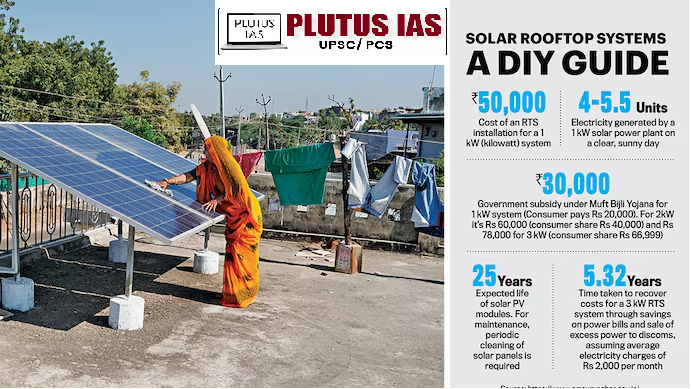14 Nov Revolution on the Rooftop: A New Dawn of Change”
SYLLABUS MAPPING:
GS-3-Environment-Revolution on the Rooftop: A New Dawn of Change”
FOR PRELIMS:
What are the key facts about the PM-Surya Ghar-Muft Bijli Yojana, and what is its significance?”
FOR MAINS:
In what ways have technological advancements, especially social media, altered the traditional dynamics of urban revolutions, particularly those that begin in public spaces like rooftops?
Why in the news?

What is PM-Surya Ghar: Muft Bijli Yojana?
PM-Surya Ghar: Muft Bijli Yojana is a government initiative aimed at promoting the adoption of rooftop solar power systems across households in India. The scheme is designed to increase the use of renewable energy while providing economic benefits to citizens by reducing their electricity bills.
1. Objective:
The primary goal of the scheme is to promote solar energy use in households, reduce the reliance on grid power, and bring down electricity costs for families.
The scheme is also in line with India’s commitment to achieving 500 GW of renewable energy capacity by 2030 and meeting its carbon reduction targets under the Paris Climate Agreement.
2. Target Beneficiaries:
12 million households are expected to benefit from this initiative.
The scheme is especially targeted at lower-income groups and underprivileged communities, enabling them to access affordable clean energy.
3. Free Solar Panels:
Under the scheme, eligible households will be provided with free rooftop solar panels. This means the government will cover the installation costs, making it accessible for people who cannot afford the initial investment in solar energy infrastructure.
4. Promoting Renewable Energy:
The scheme is part of India’s larger push to promote clean, green energy and reduce carbon emissions. It aims to add substantial capacity to India’s solar energy generation potential, aligning with the target to achieve 500 GW of renewable energy by 2030.
5. Government Support & Funding:
The scheme is being implemented with significant government support in the form of subsidies and financing options for installation and maintenance.
The Ministry of New and Renewable Energy (MNRE) and state governments are collaborating to ensure smooth implementation.
6. Environmental Impact:
The widespread adoption of rooftop solar panels under this initiative is expected to reduce India’s carbon footprint, contributing significantly to global climate action efforts.
7. Economic Benefits:
Beyond energy savings, the scheme will create job opportunities in the renewable energy sector, including installation, maintenance, and servicing of solar systems.
It will also support India’s domestic solar manufacturing industry, helping the country become more self-reliant in terms of solar equipment production.
8. Implementation Agencies: The scheme will be executed at two levels.
National Level: Managed by the National Programme Implementation Agency (NPIA).
State Level: Managed by State Implementation Agencies (SIAs), which are the Distribution Utilities (DISCOMs) or Power/Energy Departments of the respective states or UTs. Implementation Agencies: The scheme will be executed at two levels.
Significance of PM Surya Ghar-Muft Bijli Yojana:
1. Promotes Renewable Energy: Encourages the use of rooftop solar power, reducing dependence on fossil fuels.
2. Cost Savings for Households: Free solar panel installation helps families cut electricity bills by 30-50%.
3. Accessibility for All: Provides free installation and financial support, making solar power affordable, especially for low-income households.
4. Environmental Benefits: Reduces carbon emissions and supports India’s climate commitments.
5. Job Creation: Generates employment in solar energy installation, maintenance, and manufacturing.
6. Relieves Grid Pressure: Decentralizes energy production, easing the burden on the national grid.
7. Empowers Rural Communities: Improves energy access and quality of life for rural and marginalized groups.
8. Supports National Goals: Contributes to India’s renewable energy targets and sustainable development.
Challenges of PM Surya Ghar-Muft Bijli Yojana:
1. Awareness Issues: Lack of awareness and understanding of solar technology, especially in rural areas.
2. Roof Space Limitations: Not all households have enough roof space for solar installations.
3. Maintenance Challenges: Regular maintenance and technical support may be lacking in remote areas.
4. Financial Constraints: Potential delays in funding and long-term sustainability concerns.
5. Geographic Variability: Solar power effectiveness varies by region due to sunlight availability and weather conditions.
6. Technological Gaps: Issues with system efficiency and lack of affordable energy storage solutions.
7. Bureaucratic Delays: Slow application processing and complicated procedures may hinder implementation.
8. Skilled Workforce Shortage: Insufficiently trained technicians for installation and maintenance, particularly in rural areas.
9. Financing Barriers: Some households may face difficulties in securing additional funding for wiring or grid connectivity.
Way forward:
1. Increase Awareness: Launch targeted campaigns to educate households, especially in rural areas, about the benefits of solar energy.
2. Simplify Processes: Streamline application procedures and create digital platforms for easy registration and support.
3. Infrastructure Support: Provide roof assessments and region-specific solutions for solar installations.
4. Enhance Maintenance: Train local technicians and offer robust customer support for system upkeep.
5. Financial Accessibility: Introduce low-interest loans and additional subsidies for low-income groups.
6. Promote Technological Innovation: Invest in affordable energy storage and improve solar panel efficiency.
7. Monitor Progress: Regularly assess the impact of the scheme and collect feedback from beneficiaries.
8. Public-Private Partnerships: Collaborate with private companies for scaling up installations and long-term maintenance.
Conclusion:
The PM-Surya Ghar: Muft Bijli Yojana is a game-changing initiative by the Indian government to promote rooftop solar power, reduce electricity bills, and support renewable energy goals. By providing free solar panels to 12 million households it helps drive India’s transition to clean energy while generating jobs and reducing carbon emissions. However, challenges like limited awareness, roof space, maintenance, and regional disparities remain. To ensure success, the government must streamline processes, enhance local support, and invest in infrastructure and technology. With these steps, the scheme can significantly contribute to India’s energy future, making solar power accessible and sustainable for millions.
Download Plutus IAS Current Affairs ENG 14 Nov 2024 pdf
(250 words, 15 marks)




No Comments